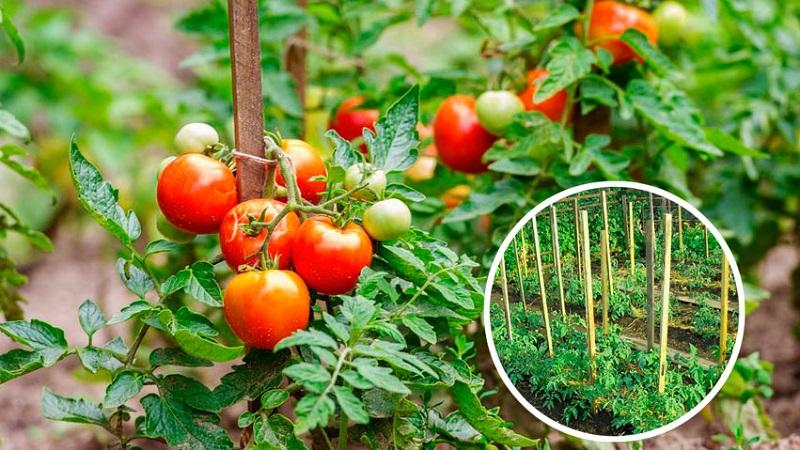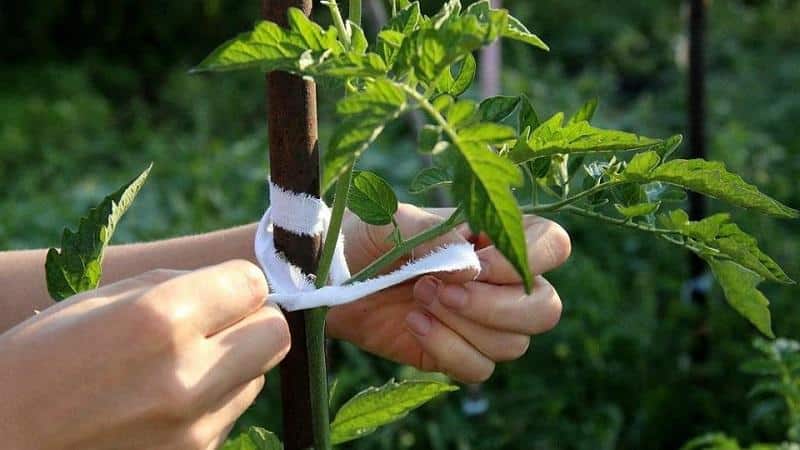How to grow and tie tall tomatoes
Tomato lovers often argue about how to tie up tall tomatoes. It turns out that there are many subtleties in this seemingly simple matter. Let's look at the secrets of care and figure out how to tie up tall tomatoes in open ground and in greenhouses.
Benefits of tall tomatoes
Do you know how low-growing tomatoes differ from tall ones? It's not just the height of the bushes. Tall tomatoes (also called indeterminate) do not stop growing after the ovary has formed.. The rest of the tomatoes, they are called determinate, stop growing after the formation of fruit clusters.

The main advantages of tall varieties of tomatoes are the duration of their fruiting and productivity. Throughout the entire season, up to 40-50 fruiting clusters can be formed on the bush.
Interesting on the topic:
Secrets of planting and caring for tomatoes
How to feed tomatoes during flowering in the greenhouse and fruiting
Top 25 sweetest varieties of tomatoes and tips on choosing them for every gardener
Features of cultivation
If you decide to plant tall tomatoes, pay attention to the important stages of their cultivation and care recommendations:
| Stage/Type of work |
Recommendations |
| Disembarkation | Tall tomatoes are planted at a distance of about 50 cm from each other. The soil is mulched. This prevents the plants from drying out. |
| Bush formation | How to properly form tall tomatoes in a greenhouse and open ground? The most important rule is to form a bush into one stem. Then the plant will not waste energy on several shoots. When to pinch tall tomatoes? Pinching is done when you need to stop the growth of a tomato. |
| Stepsoning | Experienced tomato growers recommend be sure to plant tall tomatoes. This preserves the plant’s strength and improves the quality of the fruit. Stepchildren (shoots in the leaf axils) are removed until they reach a height of 5 centimeters. They are plucked out by hand. After pinching tomatoes, it is not recommended to water them immediately. It's better to wait at least one day. This is necessary so that the wounds from removing the stepsons heal and the plant regains its strength faster.
If the stepson grows too big, he is cut out with scissors. The cut stepson can be planted in the ground. It will most likely take root and also bear fruit. |
| Leaf trimming | If the plants branch and touch each other, it is recommended to trim the touching leaf blades. This will help:
|
| Garter | This stage is important for normal fruit ripening. You can tie tomatoes to pegs, a wire frame, a mesh fence, greenhouse supports, and also use horizontal trellises. Let's look at the details below. |
Why tie up tomatoes?
There are several reasons not to neglect the garter:
- When the plant begins to set fruit, it may not be able to withstand the sudden increase in load on the trunk and break.
- Between tied tomatoes, air circulates better and sunlight penetrates.
- Tomatoes that do not lie on the ground get sick less.
- On the surface of the ground, tomatoes are more often eaten by slugs.
Important! Tethered bushes are easier to water and process.

How to tie
Both in the greenhouse and in the open ground For gartering tall tomatoes, the following methods are used:
| How to tie it up | Peculiarities |
| To the pegs | Wooden pegs are usually used. Less often - metal or plastic. They are installed in the ground near the bushes, and then the plants are tied to pegs. Some tomato growers prefer to install several supports for reliability. It is recommended to make a stake longer than the maximum growth of the tomato bush. |
| wire frame | It looks like a cell inside of which a tomato grows. The structure is made of metal wire. It can also be plastic or wooden - from slats connected to each other. |
| mesh fence | It looks like an improvised fence made of metal or plastic mesh, which is installed between the rows. Plants are tied to this “fence”. |
| Horizontal trellises | Twine or ropes are pulled horizontally between stakes dug into the ground. Plants are passed between them. |
| Vertical garter to the upper support | According to experienced tomato growers, this is the best way to garter tall tomatoes. It consists in the fact that the plants are tied vertically to supports located under the ceiling of the greenhouse or above the rows in the open ground. This method has its own tricks. Garter tapes are wrapped around the plant stem from bottom to top.If necessary (for example, if the tops of the tomatoes rest against the ceiling of the greenhouse), the tied plants can be lowered. |
Note. When tying, it is better to move the tape around the tomato stem clockwise. This is due to the fact that the movement of the sun occurs in this direction, and the tomatoes turn around after it.
What to tie
Regardless of the method in which the garter is made, tall tomatoes can be tied up:
- twine;
- ropes;
- thick sewing yarn;
- braid;
- long strips of soft cloth (rags);
- nylon tights.
Using tights is a life hack from experienced tomato growers. They note this garter material as the safest for plant trunks.

Let's sum it up
In Russia, gardeners most often grow tomatoes in a greenhouse. Caring for tall tomatoes both in the greenhouse and in the open ground have common points. Among them are timely pinching of plants, formation of a bush into one stem and tying. Care for tall tomatoes correctly, and they will delight you with a good harvest all season long.